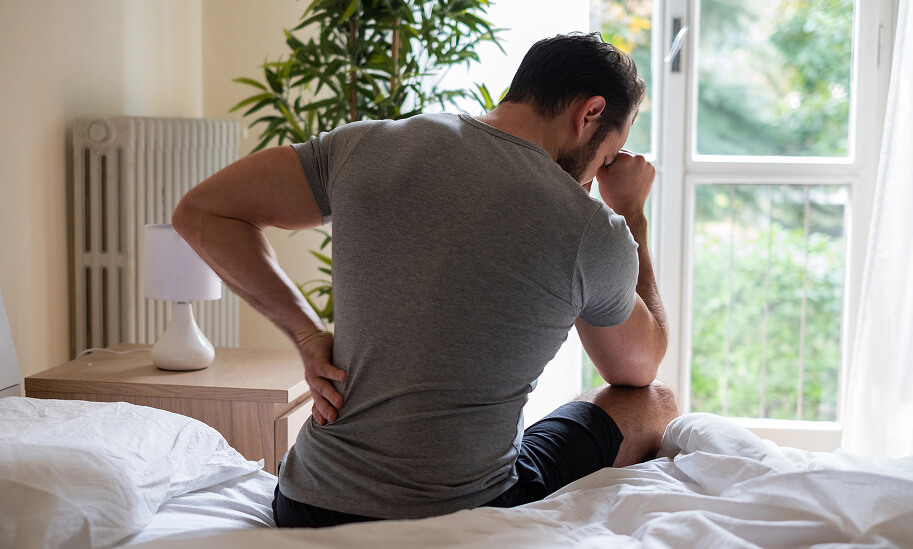Hip pain is a common issue that can severely impact one’s quality of life, especially for individuals in their 40s and beyond. Many people assume their hip discomfort is solely related to joint issues such as arthritis or bursitis, but another condition, sciatica, may be the true culprit behind the pain. Understanding this crucial link can not only lead to more accurate diagnoses but also enable more effective treatments for long-lasting relief.
What is Sciatica?
Sciatica refers to pain that radiates along the path of the sciatic nerve, which extends from the lower back through the hips and buttocks, down each leg. This condition is often a result of nerve compression, typically caused by a herniated disc, bone spurs, or spinal stenosis. While many associate sciatica with lower back pain, the pain can be felt throughout the leg and sometimes into the foot, with symptoms ranging from mild aches to sharp, shooting pains. Uniquely, sciatica doesn’t just affect the lower back but can mimic hip pain, especially when the nerve’s roots are irritated near the pelvic region. What’s less commonly discussed is how prolonged pressure on the sciatic nerve can lead to muscle weakness or difficulty moving, which often gets overlooked as part of the discomfort from sciatica. This can compound existing hip issues and make treatment more complex.
How Sciatica Can Cause Hip Pain
- Nerve Root Compression: When a herniated disc or bone spur compresses the nerve roots of the sciatic nerve near the spine, it can cause referred pain that radiates into the hip. This pain may be mistaken for a primary hip issue when in reality, it originates from the lower back. The pain may vary in intensity but often increases with certain movements like sitting for long periods or twisting motions.
- Muscle Tightness and Spasms: Sciatica can lead to muscle tightness in the lower back and glutes, which can then affect the muscles surrounding the hip joint. Tightness in these muscles can cause discomfort in the hip area, restricting movement and potentially exacerbating any pre-existing hip problems, such as arthritis or tendonitis.
- Altered Gait and Posture: The discomfort caused by sciatica can lead individuals to alter their gait to avoid exacerbating the pain. This change in walking mechanics can place extra strain on the hip joint, leading to further pain and discomfort. Prolonged poor posture or altered movement patterns can put unnecessary pressure on the hip and its surrounding structures.
- Sciatic Nerve Irritation Near the Hip: The sciatic nerve runs close to the hip joint and may become irritated or inflamed due to inflammation in the surrounding areas. When the nerve is irritated near the hip, it can mimic the sensations of hip pain, leading to confusion when trying to diagnose the true cause of discomfort. This overlap makes it difficult for many individuals to differentiate between sciatica-related hip pain and primary hip joint issues.
Sciatica vs. Hip Pain: How to Differentiate the Two
Differentiating between sciatica and hip pain can be challenging due to the overlapping symptoms. One key distinction lies in the location of the pain. Sciatica often starts in the lower back or buttocks and radiates down the leg, whereas hip pain is generally localized to the front, side, or outer portion of the hip area. Movement patterns also provide clues: sciatica pain tends to worsen with activities that involve bending, sitting for long periods, or twisting the spine, while hip pain often intensifies with weight-bearing activities like walking, climbing stairs, or rotating the hip.
Additionally, sciatic nerve pain is typically sharp, shooting, or burning in nature and may come with tingling or numbness in the leg. Hip pain, on the other hand, is more likely to feel dull, aching, or stiff and may be associated with limited mobility in the hip joint. When in doubt, seeking medical advice is essential to correctly identify and treat the underlying cause.
Diagnosis: How to Know if Sciatica is Behind Your Hip Pain
To determine if sciatica is causing your hip pain, a thorough evaluation by a healthcare professional is essential. This often includes a detailed medical history, physical examination, and neurological tests to assess the function of the sciatic nerve. Imaging tests, like an X-ray, MRI, or CT scan, may be recommended to check for nerve compression or disc issues. Your doctor may also perform specific maneuvers, such as the straight leg raise test, to provoke sciatic pain and differentiate it from hip-related discomfort. A correct diagnosis ensures the most effective treatment approach.
Treatment Options for Sciatica-Related Hip Pain
- Physical Therapy: Targeted exercises to strengthen the muscles surrounding the sciatic nerve and improve flexibility can significantly alleviate pain. Specific stretches and strengthening exercises may help to relieve pressure on the nerve and improve mobility.
- Chiropractic Care: Adjustments to the spine and pelvis by a chiropractor can often provide relief from sciatic nerve irritation, helping to restore proper alignment and reduce nerve compression.
- Medications: Over-the-counter pain relievers such as NSAIDs can help reduce inflammation, but stronger medications, like muscle relaxants or nerve pain medications, may be prescribed for more severe cases.
- Epidural Steroid Injections: If pain persists, corticosteroid injections directly into the affected area can reduce inflammation around the sciatic nerve, providing temporary relief and facilitating rehabilitation.
- Surgical Intervention: In rare cases, when other treatments fail, surgical options may be considered to relieve pressure on the sciatic nerve, such as a discectomy or laminectomy.
- Alternative Therapies: Acupuncture and massage therapy are also worth exploring, as they can help manage the discomfort associated with sciatica, promoting blood flow and relaxing tense muscles.
Prevention Tips: How to Avoid Sciatica and Hip Pain
Maintaining proper posture is crucial for preventing sciatica and hip pain. Poor posture, especially during long periods of sitting or standing, can put undue strain on the lower back and hip regions, leading to sciatic nerve irritation. It’s important to ensure your spine is aligned and avoid slumping to reduce pressure on the sciatic nerve.
Staying active with low-impact exercises, such as walking, swimming, or cycling, can help strengthen the muscles around your hips and lower back, providing better support and reducing the risk of strain.
Your sleeping position also plays a key role in preventing hip and sciatic pain. Sleeping on your side with a pillow between your knees or on your back with a pillow under your knees can help maintain spinal alignment and reduce pressure on the hips.
When lifting heavy objects, be sure to use proper techniques by bending at the knees rather than the waist, and avoid twisting motions that could strain your lower back and hips.
Lastly, incorporating stretching into your daily routine, especially for the hamstrings, lower back, and hips, can help alleviate tightness that contributes to sciatic nerve irritation and hip discomfort. Regular stretching helps keep muscles flexible and reduce the risk of developing pain.
Conclusion
Sciatica and hip pain can often overlap, making it difficult to distinguish between the two. Understanding the connection and symptoms is key to effectively managing and treating your pain. If you’re experiencing persistent discomfort or difficulty determining the source of your hip pain, it’s important to seek professional evaluation and treatment. At SFHips, we specialize in diagnosing and treating both sciatica and hip-related conditions with personalized care and advanced treatment options. Don’t let pain disrupt your life—visit us or call (415) 530-5330 today to schedule an appointment and start your path to recovery.









